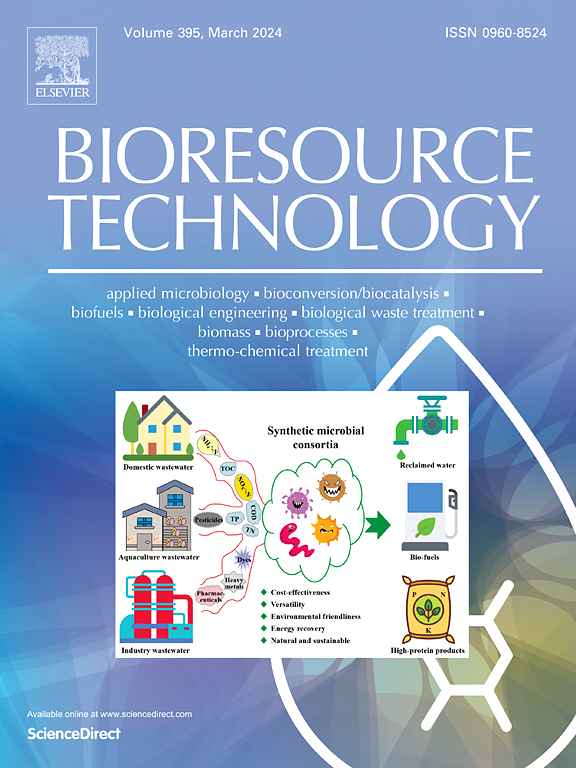时间序列转录组学分析揭示了驯化群落中优势菌株的生存策略及其对共培养中聚羟基烷酸酯合成的影响。
IF 9.7
1区 环境科学与生态学
Q1 AGRICULTURAL ENGINEERING
引用次数: 0
摘要
混合微生物培养越来越多地用于提高增值代谢物如聚羟基烷酸酯(PHA)的生产。然而,种间相互作用在形成PHA产量和单体组成中的作用尚不清楚。本研究研究了活性污泥富集的山东副球菌wg2和小Brevundimonas R79两种PHA产菌在不同碳源下对PHA产菌量和基因表达的影响。当提供乙酸时,单独培养的wg2产生最高的PHA含量,然而,与R79共培养的wg2导致PHA积累减少,主要是由于底物竞争。R79不能代谢丙酸,仅表现出由内部储备维持的短暂生长,从而使wg2成为丙酸的主要消费者。在混合碳条件下,与wg2单培养相比,共培养提高了聚(3-羟基丁酸盐-co-3-羟戊酸盐)(PHBV)的产量,并提高了3-羟戊酸盐(3HV)的比例,表明种间相互作用促进了单体多样化。转录组学分析显示,共培养条件诱导了wg2中关键代谢基因的差异表达。具体来说,在乙酸竞争下,与乙酸同化(acs)和PHA生物合成(phaC)相关的基因上调。在混合碳培养中,参与丙酸同化的基因(prpE, aspC, leuA)表达增加。总之,我们的研究结果强调物种相互作用调节碳通量分布和单体组成,这表明合理设计具有互补代谢能力的微生物群落可能是提高PHA产量的有希望的策略。本文章由计算机程序翻译,如有差异,请以英文原文为准。

Time-series transcriptomic analysis reveals survival strategies of dominant strains in a domesticated community and their influence on polyhydroxyalkanoates synthesis in co-culture
Mixed microbial cultures are increasingly employed to enhance the production of value-added metabolites like polyhydroxyalkanoates (PHA). However, the role of interspecies interactions in shaping PHA yield and monomer composition remains unclear. In this study, we investigated the impact of co-culturing two PHA-producing strains, Paracoccus shandongensis wg2 and Brevundimonas diminuta R79, which were enriched from activated sludge, on PHA production and gene expression under different carbon sources. When supplied with acetate, the mono-culture of wg2 yielded the highest PHA content, however, co-culturing wg2 with R79, led to reduced PHA accumulation, primarily due to substrate competition. R79 was unable to metabolize propionate and only exhibited transient growth sustained by internal reserves, thereby leaving wg2 as the dominant propionate consumer. Under mixed-carbon conditions, the co-culture demonstrated enhanced production of poly (3-hydroxybutyrate-co-3-hydroxyvalerate) (PHBV) and a higher proportion of 3-hydroxyvalerate (3HV) compared to wg2 mono-cultures, suggesting that interspecies interactions promote monomer diversification. Transcriptomic analysis revealed that co-culture conditions induced differential expression of key metabolic genes in wg2. Specifically, under acetate competition, genes associated with acetate assimilation (acs) and PHA biosynthesis (phaC) were upregulated. In mixed-carbon cultures, genes involved in propionate assimilation (prpE, aspC, leuA) showed increased expression. Overall, our findings underscore that species interactions modulate carbon flux distribution and monomer composition, suggesting that rationally designing microbial communities with complementary metabolic capabilities could serve as a promising strategy to enhance PHA production.
求助全文
通过发布文献求助,成功后即可免费获取论文全文。
去求助
来源期刊

Bioresource Technology
工程技术-能源与燃料
CiteScore
20.80
自引率
19.30%
发文量
2013
审稿时长
12 days
期刊介绍:
Bioresource Technology publishes original articles, review articles, case studies, and short communications covering the fundamentals, applications, and management of bioresource technology. The journal seeks to advance and disseminate knowledge across various areas related to biomass, biological waste treatment, bioenergy, biotransformations, bioresource systems analysis, and associated conversion or production technologies.
Topics include:
• Biofuels: liquid and gaseous biofuels production, modeling and economics
• Bioprocesses and bioproducts: biocatalysis and fermentations
• Biomass and feedstocks utilization: bioconversion of agro-industrial residues
• Environmental protection: biological waste treatment
• Thermochemical conversion of biomass: combustion, pyrolysis, gasification, catalysis.
 求助内容:
求助内容: 应助结果提醒方式:
应助结果提醒方式:


